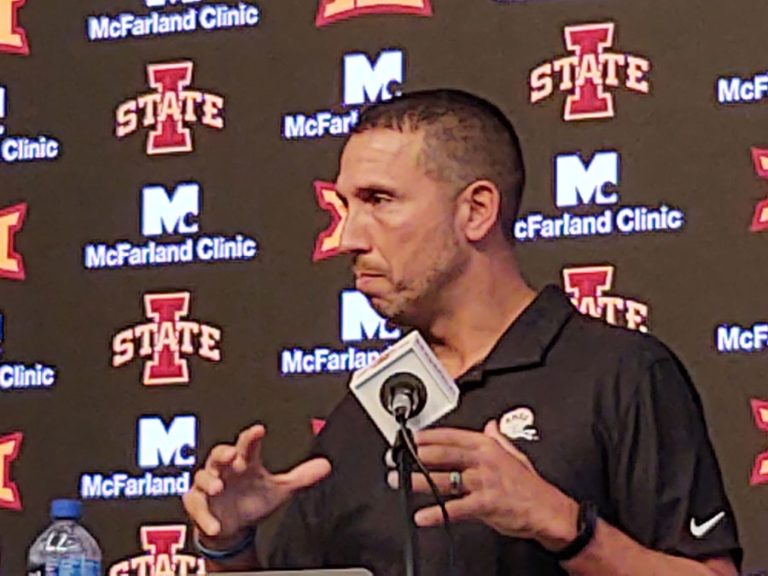Statewide Iowa — (IARN) — Iowa is hog, poultry and cattle country. It does have a number of sheep, primarily in small farm flocks.
Sheep can make money by selling wool and lambs. However, predators love lamb and can take the profit out of a year’s work in a single night. I spoke with a Midwest sheep producer who has good news and good solutions to predator problems.
Ken Root: I’m at the American Lamb Board booth, and Jim Percival, past president of the American Lamb Board is here. You’re a lamb producer in small flock country. What’s the trend as far as lamb production by smaller flocks and farmers?
Jim Percival: The great thing about smaller flocks is they’re growing. We continue to add small producers throughout the east and south. In fact, this year I spoke to the Georgia producers association. When you think Georgia, you don’t think lambs and sheep, but we had over a hundred people at the Georgia producers meeting and a lot of those have 10, 20 or 30 ewes. You add all those together and all of a sudden you’ve got 500 or 1,000 ewes. So the small production and small producers continue to grow. We continue to bring more people in.
One of the things we did this past year was our inaugural lamb summit, our educational summit. That brought over 250 people from all over the country. We went to Fort Collins, Colorado and had a two-day intensive educational program that talked about new technologies, new genetics, how we can improve and how we can become more productive and continue to provide high quality protein to our customers.
Ken Root: Let’s talk about profitability. More people would produce lambs in the Midwest if they could be profitable on the wool and also on the lamb. What is the Lamb Board doing to try to either make new products or make more money for guys/gals?
Jim Percival: I can’t speak to the wool side. But on the lamb side, the biggest thing we are charged with is increasing demand for American lamb. And demand for American lamb continues to grow throughout the country. It’s growing quite a bit in the Midwest and east because one of our biggest markets is the ethnic market.
Know your customer. That’s the critical thing we can pass along to these producers is know who your customer is. And if you do direct marketing like a lot of folks in the east, that that will continue to build your profit margin. I know people in western Ohio who had never done it before. We worked with them and they are now doing two farmer’s markets a week and are selling out of the lamb they bring to those markets. They never take anything home. That will increase your profitability.
Another way to increase your profitability is to increase your productivity. If you go from raising say one lamb per ewe to one and a half or two lambs for ewe, all of a sudden you have become twice as profitable. That’s one of the big things we were trying to do through the lamb summit, educate not only the experienced producers, but those new producers. If it’s more profitable, more people are going to do it.
Ken Root: Let me ask you a couple of quick questions about being a producer. One of them is predator control. Are you finding that you’ve got better means, either technology wise or other practices, to keep from having losses to predators?
Jim Percival: We do two things on my farm in Ohio because we have lots of predators. We’ve got coyotes, bobcats and black vultures are extremely bad in our area. One of the things I do as far as predator control is shed lamb everything. I don’t lamb in the pasture anymore because of the vulture problem. I also have livestock protection dogs. I have Great Pyrenees dogs and I use donkeys. Both of those working together are good at keeping the predators out. In fact, in the past nine years, I have not lost a lamb or ewe to predation because of the different practices. But it’s not just one thing and one size doesn’t fit all. We’ve got a lot of good trappers throughout the United States that will come in and help. If you talk to the wildlife service in your state or your local DNR, they will usually put you in contact with a trapper that can come help.
Ken Root: What breed do you produce? What breed do you recommend for Midwest growers to take a look at?
Jim Percival: I produce Shropshires. Shropshires have always been a good farm flock because of the meat production and prolific attributes of the ewe. What I think people need to do is figure out what they want to do. If you want to be a wool producer and want to sell wool to hand spinners, then Shropshire’s aren’t for you. If you want to be a meat producer, then that’s a breed I suggest you look at. The producer needs to know what they want to do, what markets they want to hit and then work with the breed that best meets their needs. The breed organizations throughout the country are more than happy to work with folks and try to bring new people in.
You can read this story, complete with interview audio by CLICKING HERE.












